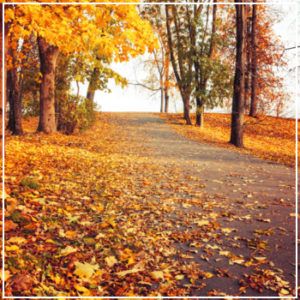
Many riders would agree, fall is prime motorcycle season. Near perfect temperatures, clear blue skies, changing leaves and less traffic on favorite backroads make for great end-of-season rides.
On the other hand, fall has a few downsides. With winter right around the corner, riders have to be mindful of freezing overnight temperatures and black ice. These hazards, combined with falling leaves, roadwork and drivers who aren’t expecting to see motorcycles this time of year, remind us to ride carefully and defensively through the end of fall.
As you enjoy the few mild autumn days we have left here in New England, keep these points in mind.
1. Beware of Fallen Leaves
Our region of the country is a must-see spot for leaf peepers – however, changing leaves have to come down eventually. When they do, they can form a slick, muddy blanket that greatly reduces tire traction. An unsuspecting motorcyclist may start to slip and slide, especially if their tire treads are worn out.
Large leaf piles can obscure potholes and uneven pavement, also catching riders by surprise. Added to this, high winds may bring small branches down with the leaves, creating another level of obstruction.
With these risks in mind, here’s how to approach a leaf-covered road this season:
- Ride around the piles, as you never know what lies underneath.
- Go slow, until you’re past the areas with fallen leaves and acorns.
- Make sure your tires have sufficient traction.
- Slow down and take care around corners.
- Never ride over broken branches, as they have potential to rip and puncture your tires.
2. Adjust to Shorter Days
When daylight saving time comes to an end, you’re more likely to end a late afternoon ride in the dark. For this reason, make sure your bike’s headlights, brake lights and turn signals are all in working order. So other motorists can see you, further make yourself visible with reflective clothing.
This time of year, the sun now sits lower in the sky. Unless you’re traveling north, this positioning often creates glare and, with fewer leaves on the trees, there is nothing to block the light. To reduce the blinding glow and any potential accidents, make sure you’re equipped with appropriate eyewear and take it slow when the sun prevents you from seeing far ahead.
3. Think About Animals
Plenty of creatures are migrating south, searching for food or seeking hibernation this time of year. Due to these factors, you’re more likely to come across deer and other medium-to-large mammals, especially at dawn and dusk. To anticipate this risk, ride with appropriate protective gear and keep your eyes peeled for animals approaching from the side of the road.
4. Cold and Fatigue
Even with plenty of warm gear, riding through cold temperatures can wear you down. If you’re unprepared, it could be a recipe for disaster. For a safe, comfortable journey, make sure you:
- Plan Journeys Carefully: Long trips should have multiple rest stops along the way.
- Layer Strategically: Be warm but not bulky with moisture-wicking base garments, insulating mid-layers, a leather jacket and pants.
- Anticipate the Weather: Bring along the right gear in preparation for rain and colder evenings.
5. Prepare for Ice
You may think early fall is too soon for ice but in shaded areas and over bridges, moisture accumulates and cold weather can cause it to freeze. Factoring in this hazard, proceed with caution if you see ice patches in these areas. Ride around icy spots and slow down to anticipate unexpected slippery areas.
On the other hand, don’t completely ignore traction. Aside from checking out the treads, be sure to retire softer rubber summer tires. This time of year, transition to a set of touring tires with a harder compound and more grip to give you an edge on slippery surfaces.
6. Anticipate Rough Roads
Although you’ll spot more potholes in spring, plenty of roadwork is done during the fall season. Construction projects may strip away the asphalt, leaving a rough, uneven or gravel-covered surface that can prove treacherous for motorcycles. Always go slow near and through work zones. If you approach a rough patch, relax and proceed with caution as you seek out smoother ground. Consider going a different route if you know there is a construction project along a particular route.
If you ride through fall, how do you approach these common hazards? Share your tips on our Facebook page.
